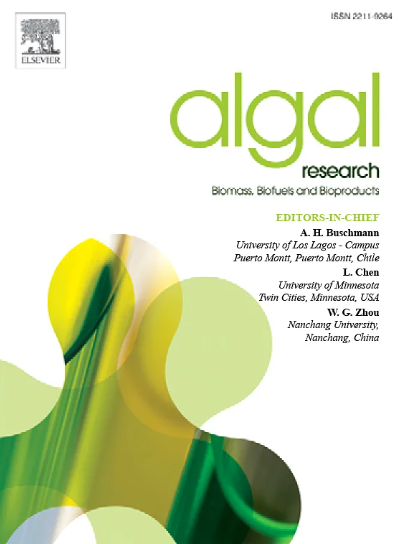Rheological characterization and modeling of freshwater and marine microalgae and cyanobacteria mixed cultures
IF 4.6
2区 生物学
Q1 BIOTECHNOLOGY & APPLIED MICROBIOLOGY
Algal Research-Biomass Biofuels and Bioproducts
Pub Date : 2025-03-07
DOI:10.1016/j.algal.2025.103988
引用次数: 0
Abstract
Rheology is crucial for algal cultivation, affecting mixing efficiency and biomass productivity. There is limited research on the rheological aspects of mixed cultures of algae and cyanobacteria. The study aimed to investigate the rheological properties of microalgae and cyanobacteria mixed cultures (Chlorella vulgaris and Microcystis aeruginosa; Nannochloropsis oceanica and Prochlorococcus sp.). While all species were spherical and non-motile with similar aspect ratios, Prochlorococcus sp. exhibited meaningful cell-cell repulsion, increasing its apparent effective volume fraction by 20–40 %. Mixed suspensions of C. vulgaris and M. aeruginosa demonstrated shear thinning at all concentrations, accurately described by a power law model across the explored shear-rate range. The conventional Einstein and Krieger-Dougherty models confirmed that viscosity increased with cell concentration, with Prochlorococcus sp. having the greatest impact. However, these models did not effectively account for mixed suspensions. A novel model, based on Pal (2023) [1] and incorporating two independent parameters, provided a greater reflection of the viscosity in mixed suspensions. Interestingly, parameters for this new mixed culture model could be derived from mono-culture rheological models within the studied concentration range. This first-of-its-kind study highlighted the significance of rheology in optimizing mixed cultures and identifies the need for further research to address rheological challenges, notably towards higher industrial-scale biomass densities.

求助全文
约1分钟内获得全文
求助全文
来源期刊

Algal Research-Biomass Biofuels and Bioproducts
BIOTECHNOLOGY & APPLIED MICROBIOLOGY-
CiteScore
9.40
自引率
7.80%
发文量
332
期刊介绍:
Algal Research is an international phycology journal covering all areas of emerging technologies in algae biology, biomass production, cultivation, harvesting, extraction, bioproducts, biorefinery, engineering, and econometrics. Algae is defined to include cyanobacteria, microalgae, and protists and symbionts of interest in biotechnology. The journal publishes original research and reviews for the following scope: algal biology, including but not exclusive to: phylogeny, biodiversity, molecular traits, metabolic regulation, and genetic engineering, algal cultivation, e.g. phototrophic systems, heterotrophic systems, and mixotrophic systems, algal harvesting and extraction systems, biotechnology to convert algal biomass and components into biofuels and bioproducts, e.g., nutraceuticals, pharmaceuticals, animal feed, plastics, etc. algal products and their economic assessment
 求助内容:
求助内容: 应助结果提醒方式:
应助结果提醒方式:


